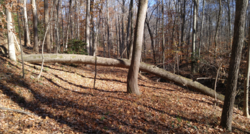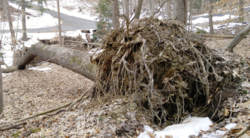I have a red oak that was a real "leaner" until it finally fell over. Once I'm finished processing some more normal trees I'm planning to tackle this bad boy but I've never bucked a tree this warped before. Anyone here have suggestions for how best to proceed? I figured I'd cut off the part overhanging the creek (far right) and then undercut my way along from right to left, but the trunk is sticking up at a pretty good angle at that point. I also thought about starting at the base or the middle where it's more level but figured I'd be guaranteed to pinch the bar if I did that. It's also pretty high in the middle (about 6' up) which doesn't thrill me. The trunk is about 28"-30" in diameter at the base and is still solid (the tree still was full of green leaves when it uprooted last summer) so I don't have to worry about it falling apart on me. Thoughts?




 That's why I thought that starting at the end opposite the roots would better allow me to "let it down gently" because the weight of the tree would counterbalance the root effect until the trunk was a much more manageable size. But all of this is theory...I'm not sure how it works out in practice. And to add one other wild card, the cross-section of the trunk is very oval with the long axis pointing up/down, which adds another dimension of potential instability.
That's why I thought that starting at the end opposite the roots would better allow me to "let it down gently" because the weight of the tree would counterbalance the root effect until the trunk was a much more manageable size. But all of this is theory...I'm not sure how it works out in practice. And to add one other wild card, the cross-section of the trunk is very oval with the long axis pointing up/down, which adds another dimension of potential instability.

 for the pine lovers out there.) I'm not new to bucking (just cut another 15 oak rounds today) but mostly I've dealt with straightforward stuff. This will be a new experience. I appreciate all the cautionary notes. I'll let you know how it goes, but we've got more snow in the forecast and I may just hold off until we're a little closer to spring.
for the pine lovers out there.) I'm not new to bucking (just cut another 15 oak rounds today) but mostly I've dealt with straightforward stuff. This will be a new experience. I appreciate all the cautionary notes. I'll let you know how it goes, but we've got more snow in the forecast and I may just hold off until we're a little closer to spring.